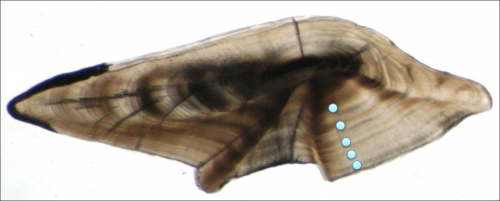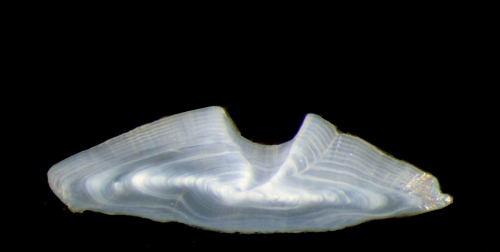Fish ear bones and their distinctive growth rings offer clues to the likely impacts of climate change in aquatic world

(Phys.org)—The earbones, or 'otoliths', help fish to detect movement and to orient themselves in the water. Otoliths set down annual growth rings that can be measured and counted to estimate the age and growth rates of fish.
"Otoliths can form the basis of new techniques for modelling fish growth, productivity and distribution in future environments," said Dr John Morrongiello of CSIRO's Wealth from Oceans Flagship, lead author of a paper published online in Nature Climate Change today.
"They are widely used to support fishery stock assessments, and are beginning to be used to measure and predict ecological responses to ocean warming and climate change.
"Millions of otoliths are archived in research laboratories and museums worldwide, and many fish species live for decades and some, such as orange roughy, live for up to 150 years.
"Their otoliths record variations in growth rates that reflect environmental conditions. Longer-lived fish and older samples take us back as far as the 1800s."

The paper, co-authored by Dr Ron Thresher and Dr David Smith of CSIRO, builds on earlier research by Dr Thresher that identified the potential of using fish 'hard parts', (such as otoliths), and deep ocean corals to understand environmental change. It outlines a framework in which Australian research institutions can analyse hard parts and assess past and future impacts on a range of species.
In the next research phase, scientists at CSIRO, the Australian Institute of Marine Science and the University of Adelaide will study selected species of commercial interest, including tiger flathead, black bream, blue gropers, barramundi and tropical snappers.
"We will use otoliths to investigate the environmental drivers of fish growth for many species around Australia," Dr Morrongiello said.
"This will allow us to generate a continental-scale evaluation of climate change impacts on Australia's fishes and help to guide the conservation and management of our aquatic environments into the future."
Dr Thresher said there had already been extensive use of hard part archives from corals to reflect on climate variability, such as El Niño events, and to reconstruct environmental histories.
"Any change identified in growth and age maturity, especially of commercially-important species, clearly has implications for forecasting future stock states and the sustainable management of fisheries," Dr Thresher said.
"A better ability to predict such change will greatly enhance our ability to forecast, manage and adapt to the impacts of climate change in marine and freshwater systems."
More information: Morrongiello, J. et al, Thresher, R. and Smith, D., Aquatic biochronologies and climate change, Nature Climate Change, 27 November 2012. www.nature.com/nclimate/journa … ll/nclimate1616.html
Journal information: Nature Climate Change
Provided by CSIRO


















